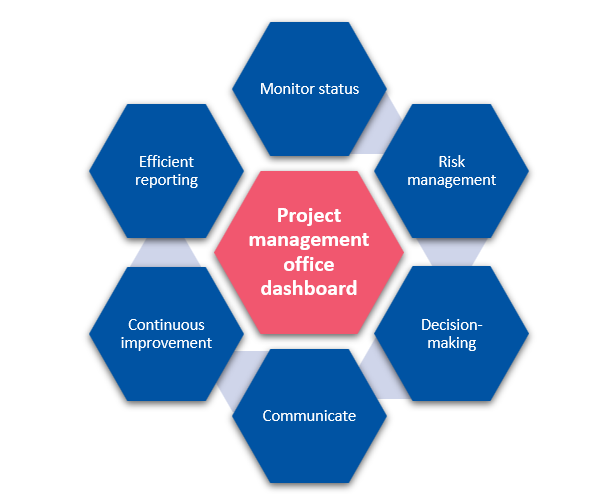
Your journey towards project management excellence
A project management office makes no sense for my organisation, or does it? SMEs and international organisations increasingly understand that good project and programme management is the key to sustainable business success. Companies often have an ambitious strategy but afterwards struggle with the practical translation into a professional project environment. A structured approach is required for starting, approving and managing both daily and strategic projects. Moreover, professional project managers need the right support. The Project/Programme/Portfolio Management Office (PMO) is the answer to all these challenges.
The Project Management Office as your reliable compass
The PMO acts as your eyes and ears, whether you are a project manager, a steering committee, an internal or external client or the board. You can rely on the information provided by the PMO to make informed decisions around your project portfolio. The PMO helps you identify and select projects and programmes that align with your business strategy and creates the right conditions for an effective and results-oriented project environment.
However, how do we ensure that the PMO has a tool to make project data easily available to these various stakeholders. And this without falling into the trap of unnecessary administration. The PMO dashboard as a project management communication tool to the entire organisation is the tool for this.
What is a PMO dashboard and what are the benefits?
SMEs and international organisations often do not have the overview of the various projects and programmes in the organisation, either high-level or detailed. "Help our organisation is a black box in terms of project management. We don't know which projects are ongoing or which are at risk". Unfortunately, this is often a quote we hear in meetings. A waste of the talents deployed on these projects it seems to us.
A Project Management Office (PMO) dashboard is used to collect, analyse and display real-time information about projects. You can think of the PMO dashboard as a project portfolio compass to the entire organisation. Using a PMO dashboard has numerous advantages, we list a few that we see in practice with our customers:
- Monitoring project progress: A PMO dashboard provides an overview of the evolution of ongoing projects. This allows project managers, programme managers, team members and stakeholders (internal and external) to quickly see where each project is in terms of schedule, budget and milestones.
- Risk management: The dashboard can include alerts and indicators for potential risks in projects. This enables the PMO and management to take proactive measures to mitigate risks before they become problematic.
- Resource management: The dashboard can include information on resource allocation, including staff availability and budgets. This helps to optimise resource management and prevent resource overload or underutilisation.
- Decision-making: The PMO dashboard provides decision makers with up-to-date data to make informed decisions. These can range from approving additional resources for a critical project to halting projects that do not appear to be profitable.
- Communication and transparency: The dashboard can be shared with stakeholders to promote transparency and keep them informed of the status of projects. This builds trust and helps engage stakeholders.
- Continuous improvement: By analysing project performance data, the PMO can identify trends and patterns. This enables the organisation to learn lessons from previous projects and continuously improve processes.
- Efficiency reporting: Using a PMO dashboard can lead to a more efficient and productive project environment, as it helps reduce manual reporting tasks and streamline the flow of information.

What is the Stanwick approach to building a PMO dashboard?
Setting up an organisation's project portfolio dashboard always starts from a good understanding of the organisation and involvement of a core team in building the PMO tool together.
Building an innovation PMO dashboard, IT PMO dashboard, Sustainability PMO dashboard or any other PMO dashboard is technically fast. From Stanwick we work for this with a project portfolio dashboard template in which we base ourselves on professional standards from PMI (https://www.pmi.org/) and at the same time complement it with insights from implementations in various sectors (construction, chemistry, pharma, ...). This gives us a minimum viable product that can be used in the organisation in the short term. We build on this with a core team and thus evolve towards a tailor-made solution for the specific needs.
More info on concrete examples from various sectors, don't hesitate to contact us.
So how do you implement a PMO?
When does an SME really need a PMO? What are the PMO's specific responsibilities and which are not? Which processes are facilitated and managed by the PMO? How do you set up a PMO and make it operational within your SME? What lines of communication and hierarchical structures should you set up? In short, how do you fit the PMO seamlessly into your organisation?
Setting up and managing a PMO requires investments in time, resources and people. We understand this all too well at Stanwick. Implementing a practical and agile PMO represents significant change within the organisation and requires the necessary change management approach.
Jeroen Van den Hove


